Low-Voltage Distribution Network Loss-Reduction Method Based on Load-Timing Characteristics and Adjustment Capabilities
Abstract
:1. Introduction
- (1)
- Addressing the distance and similarity of load curves, this paper introduces sequence variance to refine the clustering process. H-FCM is then proposed. The resulting typical load curve, formed after user classification, serves as the foundation for long-term commutation, mitigating the impact of load fluctuations on artificial commutation.
- (2)
- Recognizing the operational characteristics and adjustment methods of diverse smart homes, this paper presents a multi-objective TL optimal timing task adjustment model. Additionally, a peak-shaving control strategy is proposed to achieve the maximum sustainable power reduction for TCL.
- (3)
- The article focuses on controlling three-phase imbalance in low-voltage distribution networks from both static and real-time perspectives to enhance power quality. Simultaneously, load adjustment is employed to alter the shape of the load curve, reducing peak–valley differences and further minimizing line losses.
2. Demand-Side Resource Modeling Based on User Source Load Characteristics
2.1. Home Energy Management System Interaction Model
2.2. Modeling of Household Photovoltaic Panel Output Probability Characteristics
2.3. Load Resource Modeling Considering Scheduling Feasibility
2.3.1. Uncontrollable Load
2.3.2. Transferable Load
2.3.3. Temperature Control Load
3. Phase Sequence Adjustment Method Based on Load-Timing Characteristics
3.1. Load Classification Method Considering Distance and Similarity of Load Curves
3.2. Three-Phase Unbalanced Long-Term Commutation Model Based on Load–Power Consumption Characteristics
4. Load Peak Shedding Method Considering Smart Home Adjustment Capabilities
4.1. Multi-Objective TL Optimal Timing Task Adjustment Model
4.2. TCL’s Peak-Shaving Control Strategy for Maximum Sustainable Power Reduction Taking Comfort into Account
- (1)
- Temperature control interval constraints. According to whether the indoor temperature of the TCL device at time is within the temperature control interval , the working state vector of the motor inside the TCL device is determined as follows:
- (2)
- TCL device switching state constraint. The working state vector of the motor inside the TCL device is updated based on the switching state of the TCL device at time , This is expressed as:where is the switching state of TCL device at time .
- (3)
- Maximum sustainable reduction power constraint. During the load peak shedding period, the number of TCL internal motors that need to be shut down at time is calculated based on the preset maximum sustainable reduction power . The calculation formula is as follows:where is the power of TCL device before regulation at time ; is the rated power of the TCL device.
- (4)
- Three-phase imbalance constraint. Combined with the operating data of the low-voltage distribution network, calculate the instantaneous three-phase imbalance of the low-voltage distribution network at time , the total power of each phase, the heavy-load phase and the light-load phase in the working mode obtained after the previous update. According to Equations (21) and (22), the numbers and of motors that need to be pre-closed and started are calculated:where is the median function; is the three-phase imbalance constraint coefficient, which represents the constraints of the three-phase imbalance control strategy. The larger the value, the weaker the three-phase imbalance control effect, but the better the loss-reduction effect, .
5. Simulation
5.1. Simulation Conditions
5.2. Phase Sequence Adjustment Results
5.3. Loss-Reduction Effect
5.4. Loss-Reduction Effects in Different Scenarios
6. Conclusions
- (1)
- The introduced H-FCM algorithm not only takes into account the distance of load curves but also considers the similarity of load curves. Through load classification, a typical load curve is derived, and a long-term commutation model is established and solved using the MA algorithm. This approach reduces the influence of load uncertainty on artificial commutation results, enhancing the robustness of the long-term commutation model.
- (2)
- Considering the output characteristics of TL, this paper proposes a multi-objective TL optimal timing task adjustment model solved by IDWPSO. Additionally, a peak-cutting control strategy for maximum sustainable power reduction is introduced based on the monitoring of indoor temperature, ensuring it does not impact the user experience. The effectiveness of this strategy is validated through simulations.
- (3)
- Our approach primarily addresses issues related to three-phase imbalance and significant load peak–valley differences in low-voltage distribution networks. By incorporating manual commutation and load adjustments, this paper successfully reduces line losses. Simulation results demonstrate a noteworthy electricity savings of 318.685 kWh throughout the day, accompanied by a reduction of 1.095 percentage points in the line loss rate. The overall impact on loss reduction is substantial.
Author Contributions
Funding
Data Availability Statement
Conflicts of Interest
Appendix A
Appendix A.1
| Algorithm A1. The pseudo-code of MA |
| SP = initPop();g = 0; % Initialize group SP 1: while g < G 2: evaluateFitness(SP); % Calculate the fitness of each individual in the group 3: E = best(SP); % Keep the best individuals in the group 4: SP’ = selectForVariation(SP); % Select operator 5: SP’ = recombine(SP’); % Crossover operator 6: SP’ = mutate (SP’); % Mutation operator 7: SP’ = localSearch(SP’); % Local search operator 8: evaluateFitness(SP’); % Calculate the fitness of each individual in the parent generation 9: SP = selectNewPop(SP + SP’); % Children and parents compete together to enter the next generation 10: g = g + 1; |
| 11: end 12: print(best(SP)) |
Appendix A.2
| Algorithm A2. The pseudo-code of IDWPSO |
| set wmax,wmin,x,v,g = 0; % Initialize particle swarm 1: while g < G 2: Fit = evaluateFitness(x); % Calculate the fitness of each particle 3: E = best(x); % Keep optimal particle positions 4: x’ = selectForVariation(x); % Select operator 5: x’ = recombine(x’); % Crossover operator 6: if Fit < pbest % Update local optimal position 7: Renew(pbest); 8: end 9: if Fit < gbest % Update the global optimal position 10: Renew(gbest); 11: end 12: w = wmin + (wmax − wmin) × exp(−g/G) + σ × betarnd(p,q); % Dynamic adjustment of inertia weight 13: v = w × v + c1 × rand() × (pbest − x’) + c2 × rand() × (gbest − x’); % Update particle speed 14: x = x’ + v; % Update particle position 15: g = g + 1; |
| 16: end 17: print(best(x)) |
References
- Global Energy Internet Development Cooperation Organization. China’s Road to Carbon Neutrality; China Electric Power Press: Beijing, China, 2021. [Google Scholar]
- Ren, D.; Xiao, J.; Hou, J.; Du, E.; Jin, C.; Liu, Y. Construction and Evolution of China’s New Power System Under Dual Carbon Goal. Power Syst. Technol. 2022, 46, 3831–3839. [Google Scholar] [CrossRef]
- Ma, X.; Jia, R.; Liang, C.; Wang, W.; Xu, R. Review of Research on Loss Reduction in the Context of High Penetration of Renewable Power Generation. Power Syst. Technol. 2022, 46, 4305–4315. [Google Scholar] [CrossRef]
- Wang, X.; Ji, Y.; Wang, J.; Zhao, Y.; Ye, P.; Qi, L.; Yang, S.; Liu, S.; Ye, J. Research on Reconfiguration of Distribution Network considering Three-Phase Unbalance. Wirel. Commun. Mob. Comput. 2022, 2022, 9906100. [Google Scholar] [CrossRef]
- Samende, C.; Bhagavathy, S.M.; McCulloch, M. Distributed State of Charge-Based Droop Control Algorithm for Reducing Power Losses in Multi-Port Converter-Enabled Solar DC Nano-Grids. IEEE Trans. Smart Grid 2021, 12, 4584–4594. [Google Scholar] [CrossRef]
- Cui, X.; Ruan, G.; Vallée, F.; Toubeau, J.-F.; Wang, Y. A Two-Level Coordination Strategy for Distribution Network Balancing. IEEE Trans. Smart Grid 2024, 15, 529–544. [Google Scholar] [CrossRef]
- Hashmi, M.U.; Koirala, A.; Ergun, H.; Van Hertem, D. Flexible and curtailable resource activation in a distribution network using nodal sensitivities. In Proceedings of the 2021 International Conference on Smart Energy Systems and Technologies (SEST), Vaasa, Finland, 6–8 September 2021; pp. 1–6. [Google Scholar]
- Islam, M.R.; Lu, H.; Hossain, J.; Islam, M.R.; Li, L. Multiobjective Optimization Technique for Mitigating Unbalance and Improving Voltage Considering Higher Penetration of Electric Vehicles and Distributed Generation. IEEE Syst. J. 2020, 14, 3676–3686. [Google Scholar] [CrossRef]
- Javadi, S.; Bento, A.; Costa, P.; Paraíso, G.; Lijun, Z.; Pinto, S.; Silva, J.F. Grid current unbalance compensation using a fuzzy controlled smart transformer. Electr. Power Syst. Res. 2022, 209, 108041. [Google Scholar] [CrossRef]
- Pan, J.; Liu, J.; Chen, X.; Zhong, K. Three-phase unbalanced load control based on load–electricity transfer index. Energy Rep. 2021, 7, 312–318. [Google Scholar] [CrossRef]
- Wang, E.; Qin, L.; Huangfu, C.; Zhu, Z.; Wang, H.; Chen, J. Three-phase Unbalance Adjustment Method for Distribution Station Areas Based on Spatial Distribution and Time-series Characteristics. Autom. Electr. Power Syst. 2023, 47, 97–105. [Google Scholar]
- Liu, S.; Lin, Z.; Li, J.; Wen, F.; Ding, Y.; Wang, Q.; Lu, F.; Yang, L. Bi-level Optimal Placement Model of Phase Switch Devices for Mitigating Three-Phase Unbalance in Low-Voltage Areas. IEEE Trans. Power Syst. 2022, 37, 3149–3152. [Google Scholar] [CrossRef]
- Li, J.; Wang, G.; Zhang, M.; Fan, J.; Liu, S.; Lin, Z. Siting and Sizing Planning of Automatic Commutation Device for Three-phase Unbalance Mitigation in Distribution Station Area. Autom. Electr. Power Syst. 2022, 46, 62–69. [Google Scholar]
- Arshad, S.B.; Che, Y.B.; Liu, Y.S.; Ahmed, A.; Athar, M.; Afzaal, M.U. Energy Management Frameworks in HEMS: A Review. In Proceedings of the 2023 International Conference on Emerging Power Technologies (ICEPT), Topi, Pakistan, 6–7 May 2023; pp. 1–6. [Google Scholar]
- Wang, C.; Yang, J.; Ju, W.; Gu, F.; Chen, J.; Ji, Y. Short term load forecasting and peak shaving optimization based on intelligent home appliance. J. Zhejiang Univ. Eng. Sci. 2020, 54, 1418–1424. [Google Scholar]
- Liu, Z.; Sun, Y.; Li, Y.; Xu, Q.; Yu, T.; Pang, Y. Demand response strategy for distributed photovoltaic smart community based on model prediction of user behavior analysis. J. Shandong Univ. Eng. Sci. 2022, 52, 24–34. [Google Scholar]
- Rigo-Mariani, R.; Ahmed, A. Smart home energy management with mitigation of power profile uncertainties and model errors. Energy Build. 2023, 294, 113223. [Google Scholar] [CrossRef]
- Li, J.; Wang, Z.; Yan, S.; Wang, C.; Bao, L.; Qin, H. Optimal operation of home energy management system considering user comfort preference. Acta Energiae Solaris Sin. 2020, 41, 51–58. [Google Scholar]
- Hammou Ou Ali, I.; Ouassaid, M.; Maaroufi, M. An efficient appliance scheduling approach for cost and peak minimization in a smart home. Electr. Eng. 2023, 105, 1683–1693. [Google Scholar] [CrossRef]
- Youssef, H.; Kamel, S.; Hassan, M.H.; Nasrat, L. Optimizing energy consumption patterns of smart home using a developed elite evolutionary strategy artificial ecosystem optimization algorithm. Energy 2023, 278, 127793. [Google Scholar] [CrossRef]
- Alfaverh, F.; Denaï, M.; Sun, Y. User Comfort-Oriented Home Energy Management System Under Demand Response. In Proceedings of the 2023 IEEE IAS Global Conference on Emerging Technologies (GlobConET), London, UK, 19–21 May 2023; pp. 1–7. [Google Scholar]
- Yang, H.; Gao, Y.; Ma, Y.; Zhang, D. Optimal Modification of Peak-Valley Period Under Multiple Time-of-Use Schemes Based on Dynamic Load Point Method Considering Reliability. IEEE Trans. Power Syst. 2022, 37, 3889–3901. [Google Scholar] [CrossRef]
- Alfaverh, F.; Denai, M.; Sun, Y. A Dynamic Peer-to-Peer Electricity Market Model for a Community Microgrid with Price-Based Demand Response. IEEE Trans. Smart Grid 2023, 14, 3976–3991. [Google Scholar] [CrossRef]
- Nematirad, R.; Ardehali, M.M.; Khorsandi, A.; Mahmoudian, A. Optimization of Residential Demand Response Program Cost with Consideration for Occupants Thermal Comfort and Privacy. IEEE Access 2024, 12, 15194–15207. [Google Scholar] [CrossRef]
- Ma, M.; Liu, Y. Stochastic optimal dispatch of power system with wind power considering demand response of residential ahybrid energy system. Acta Energiae Solaris Sin. 2022, 43, 11–20. [Google Scholar] [CrossRef]
- Li, Z.; Xu, Y.; Feng, X.; Wu, Q. Optimal Stochastic Deployment of Heterogeneous Energy Storage in a Residential Multienergy Microgrid with Demand-Side Management. IEEE Trans. Ind. Inform. 2021, 17, 991–1004. [Google Scholar] [CrossRef]
- Li, Z.; Wu, L.; Xu, Y.; Zheng, X. Stochastic-Weighted Robust Optimization Based Bilayer Operation of a Multi-Energy Building Microgrid Considering Practical Thermal Loads and Battery Degradation. IEEE Trans. Sustain. Energy 2022, 13, 668–682. [Google Scholar] [CrossRef]
- Ma, K.; Fang, L.; Kong, W. Review of distribution network phase unbalance: Scale, causes, consequences, solutions, and future research direction. CSEE J. Power Energy Syst. 2020, 6, 479–488. [Google Scholar] [CrossRef]
- Q/GDW 1519-2014; Regulations of Operating and Maintenance for Distribution Network. State Grid Corporation of China: Beijing, China, 2014.
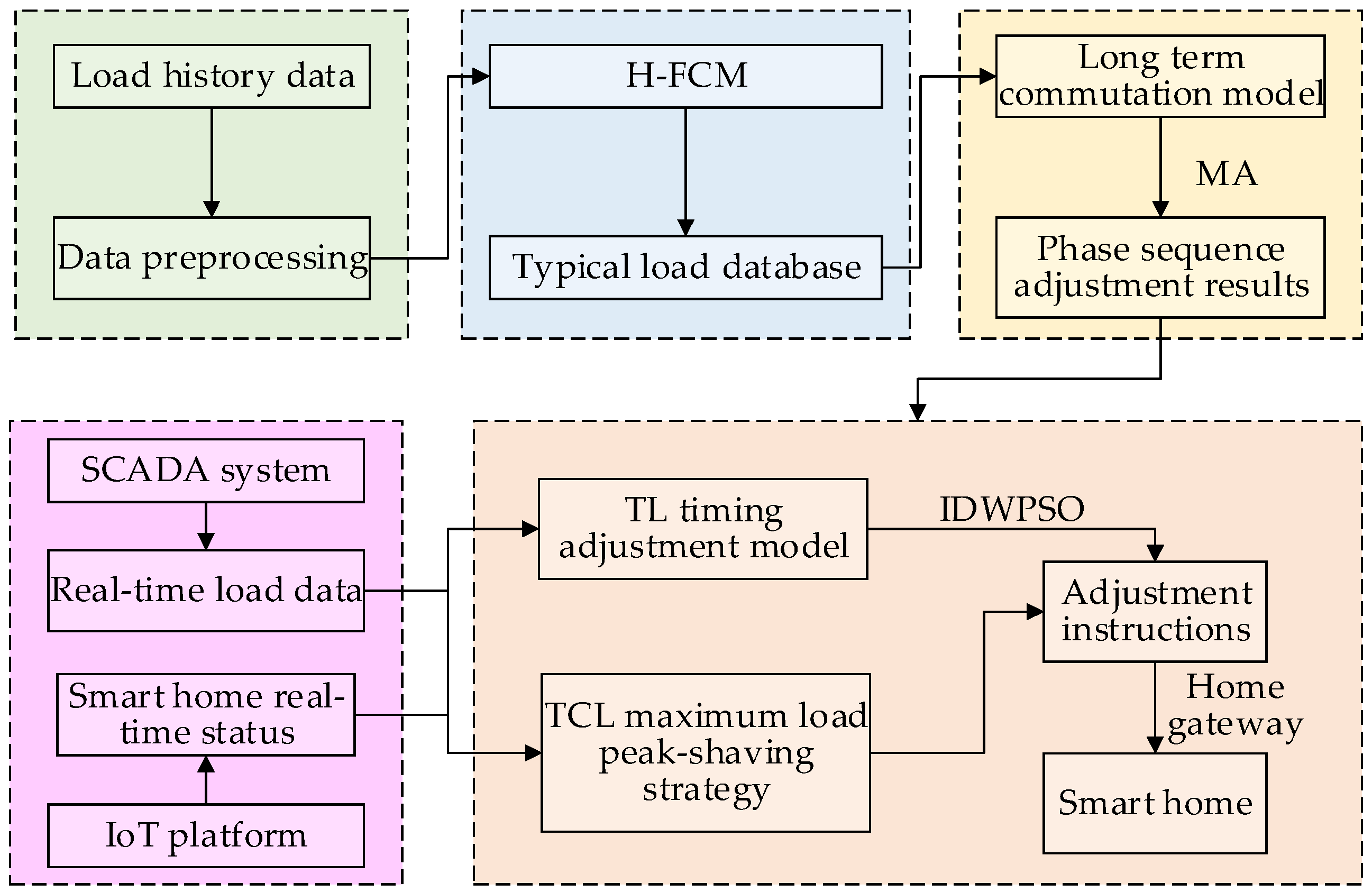
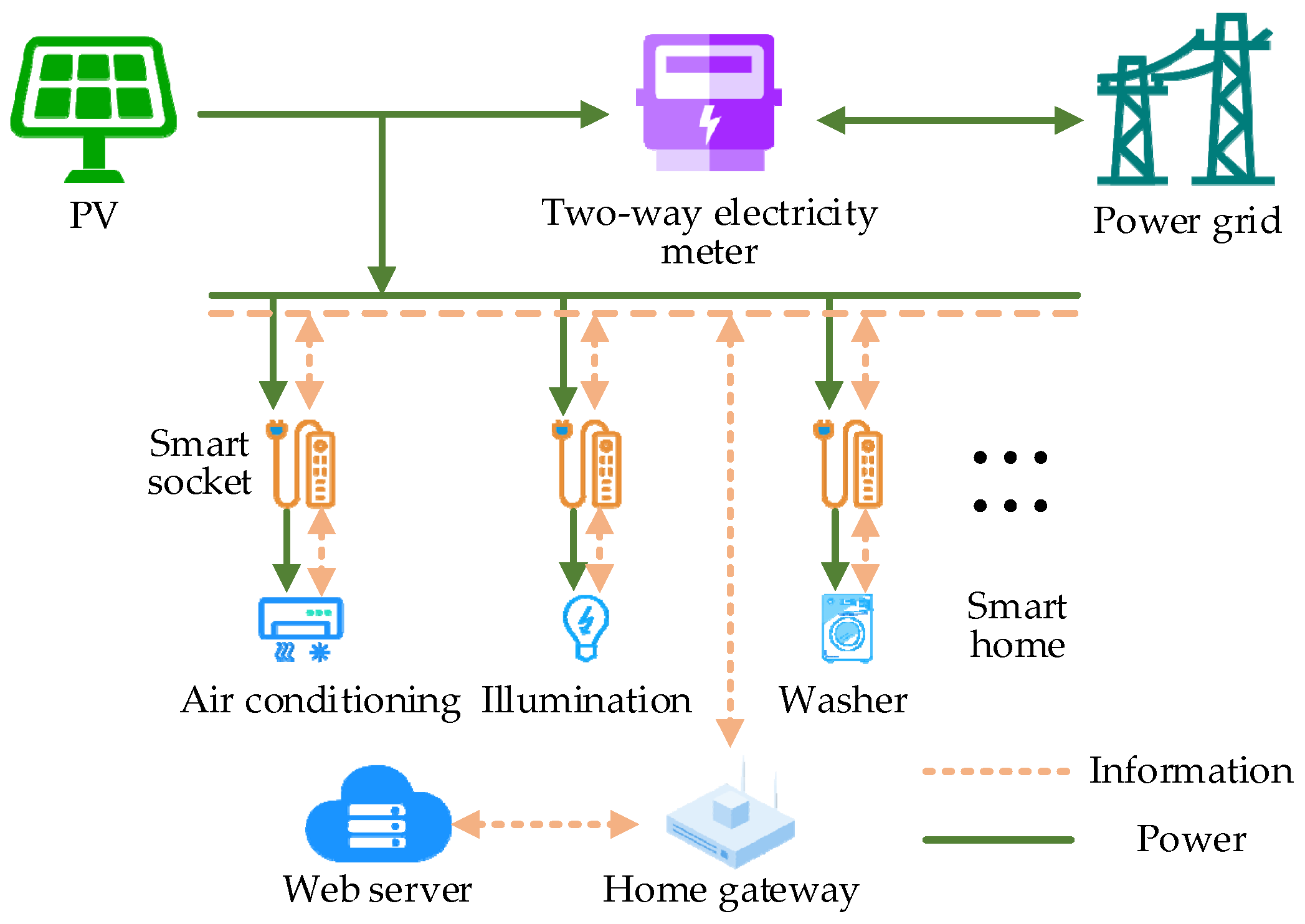
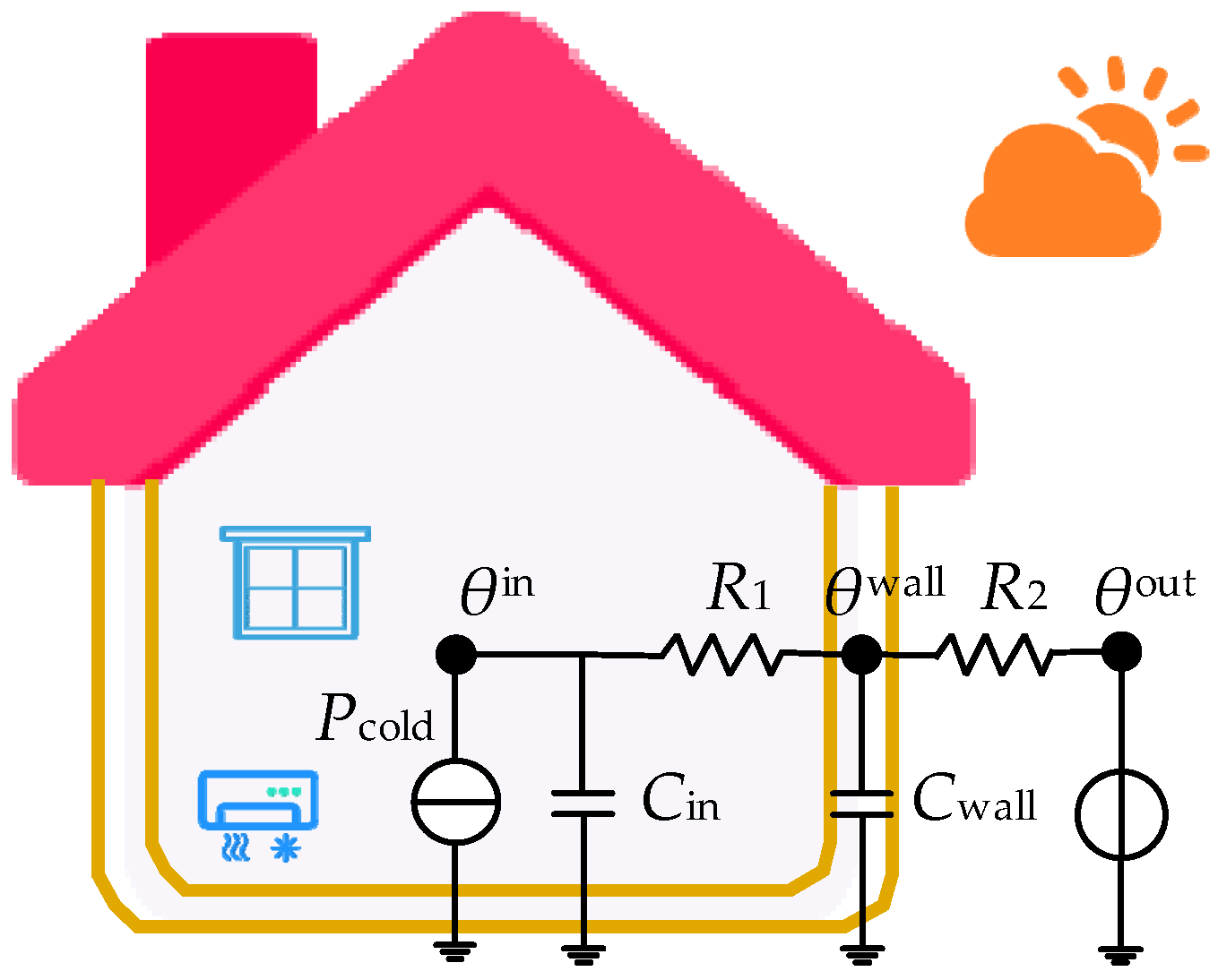
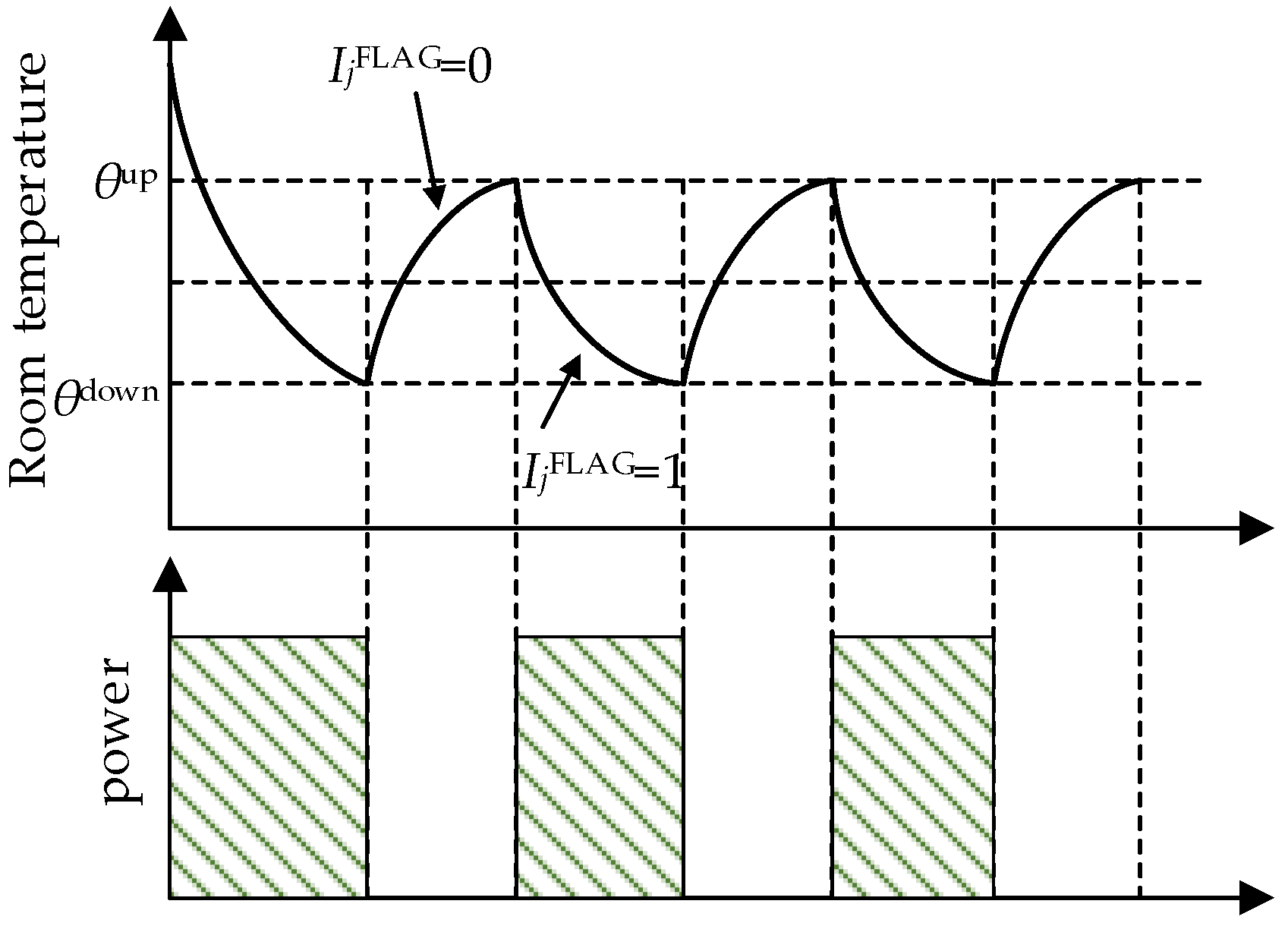
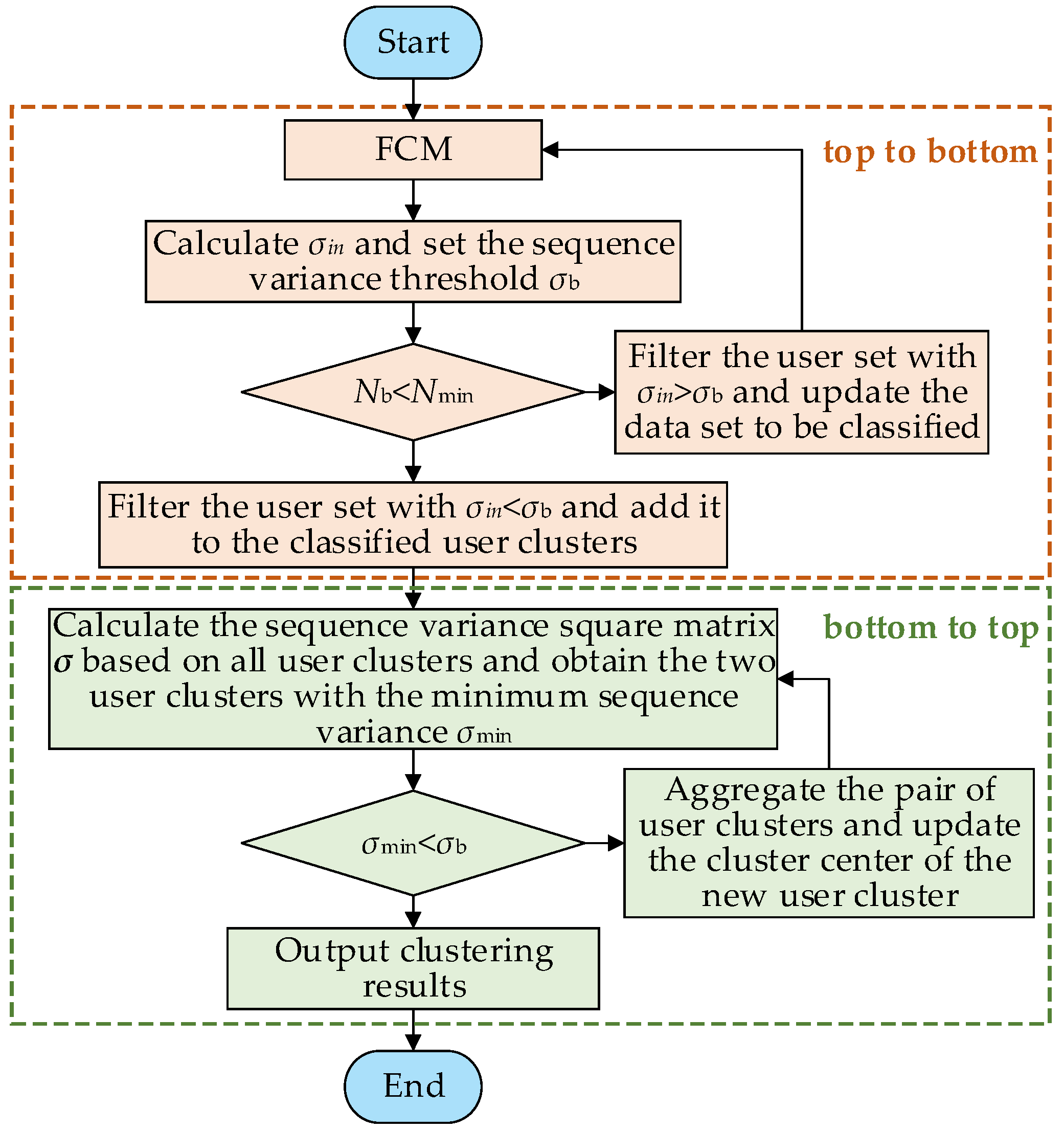


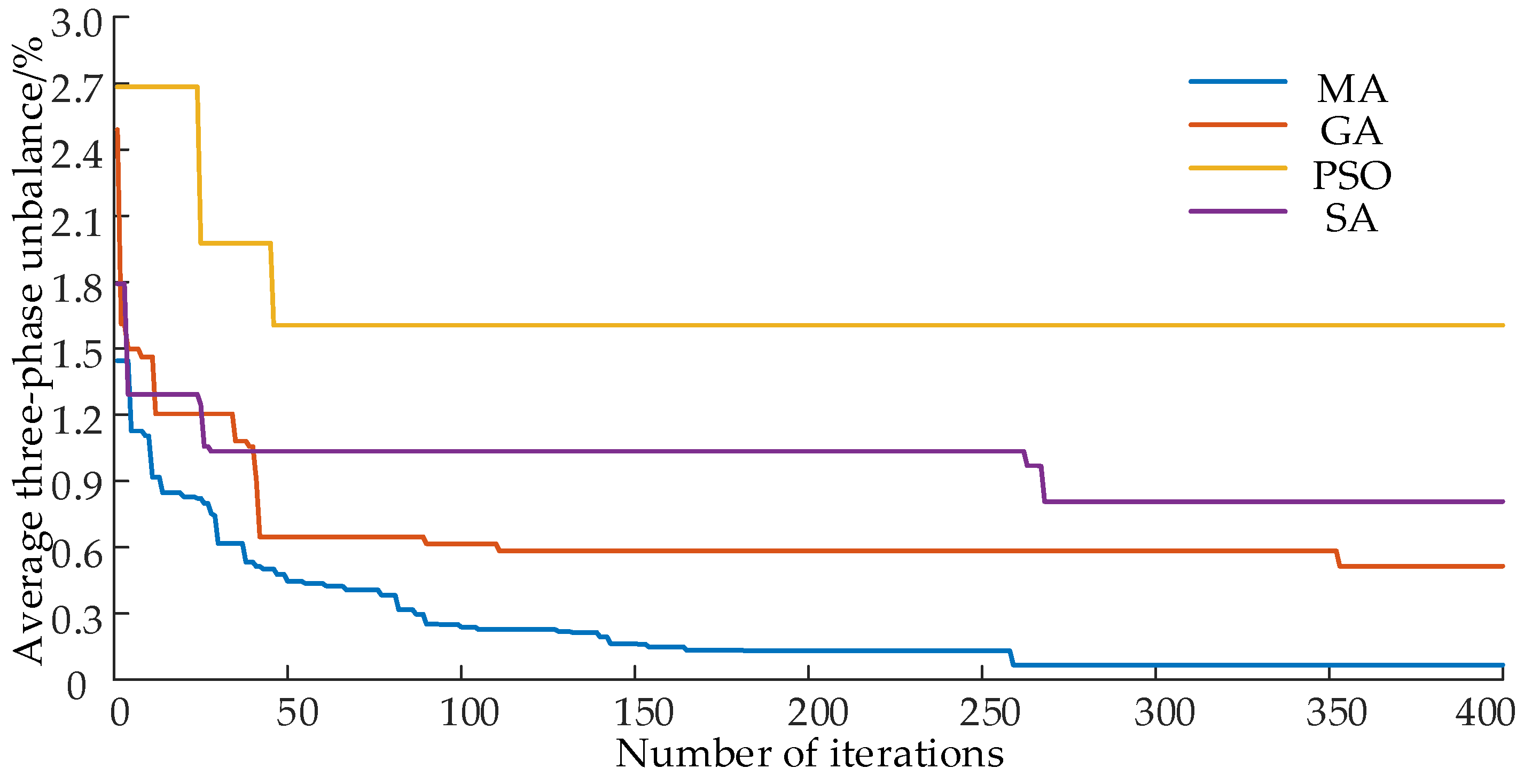

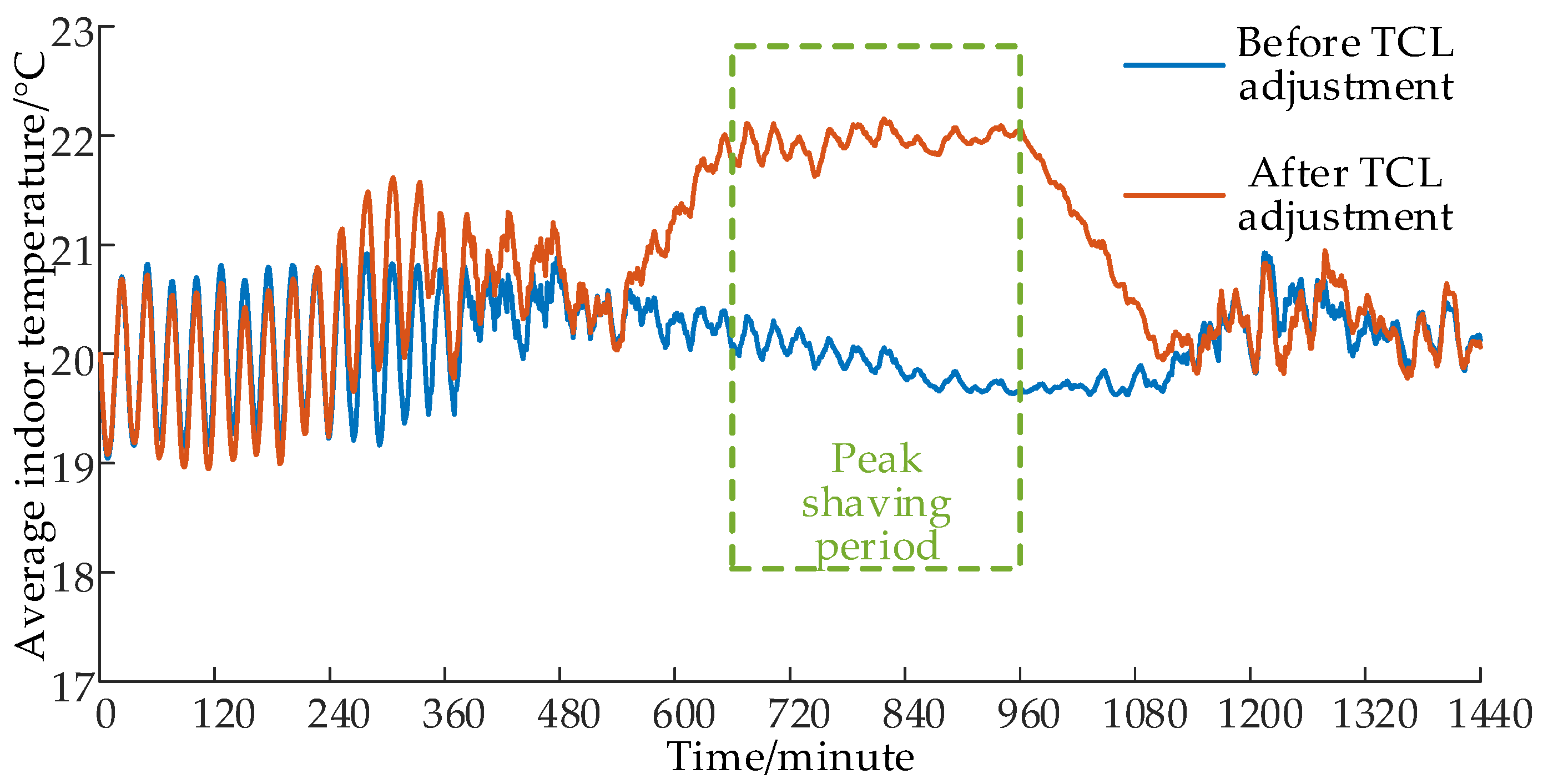



| Load Type | Smart Home | Power Characteristics | Interruptible | Transferable |
|---|---|---|---|---|
| UL | Hair dryer | Low-power or ready-to-use devices | × | × |
| Socket | ||||
| Refrigerator | ||||
| Fan | ||||
| Illumination | ||||
| Television | ||||
| TL | Dishwasher | Constant power | × | √ |
| Washer | ||||
| Water heater | ||||
| Dryer | ||||
| TCL | Air conditioning | Variable power | √ | × |
| Heating |
| Load Type | Opening Moment | Running Time/h | Use Ratio | Rated Power/W |
|---|---|---|---|---|
| TL | 100% | 1200 | ||
| TCL | daytime | 100% | 2500 | |
| night | 60% | 2500 |
| R1/(°C/W) | R2/(°C/W) | Cin/(J/°C) | Cwall/(J/°C) |
|---|---|---|---|
| 0.57 × 10−2 | 7.23 × 10−4 | 2.18 × 105 | 1.96 × 107 |
| Simulation Scenarios | Average Three-Phase Imbalance | Peak-to-Valley Ratio | Line Loss Rate | Line Loss |
|---|---|---|---|---|
| #S1 | 47.661% | 4.694 | 4.632% | 1053.142 kW·h |
| #S2 | 9.084% | 5.104 | 4.299% | 1004.333 kW·h |
| #S3 | 7.828% | 5.136 | 4.294% | 1003.091 kW·h |
| #S4 | 5.747% | 4.794 | 3.962% | 873.437 kW·h |
| #S5 | 4.468% | 4.800 | 3.949% | 868.856 kW·h |
Disclaimer/Publisher’s Note: The statements, opinions and data contained in all publications are solely those of the individual author(s) and contributor(s) and not of MDPI and/or the editor(s). MDPI and/or the editor(s) disclaim responsibility for any injury to people or property resulting from any ideas, methods, instructions or products referred to in the content. |
© 2024 by the authors. Licensee MDPI, Basel, Switzerland. This article is an open access article distributed under the terms and conditions of the Creative Commons Attribution (CC BY) license (https://creativecommons.org/licenses/by/4.0/).
Share and Cite
Huangfu, C.; Wang, E.; Yi, T.; Qin, L. Low-Voltage Distribution Network Loss-Reduction Method Based on Load-Timing Characteristics and Adjustment Capabilities. Energies 2024, 17, 1115. https://doi.org/10.3390/en17051115
Huangfu C, Wang E, Yi T, Qin L. Low-Voltage Distribution Network Loss-Reduction Method Based on Load-Timing Characteristics and Adjustment Capabilities. Energies. 2024; 17(5):1115. https://doi.org/10.3390/en17051115
Chicago/Turabian StyleHuangfu, Cheng, Erwei Wang, Ting Yi, and Liang Qin. 2024. "Low-Voltage Distribution Network Loss-Reduction Method Based on Load-Timing Characteristics and Adjustment Capabilities" Energies 17, no. 5: 1115. https://doi.org/10.3390/en17051115





